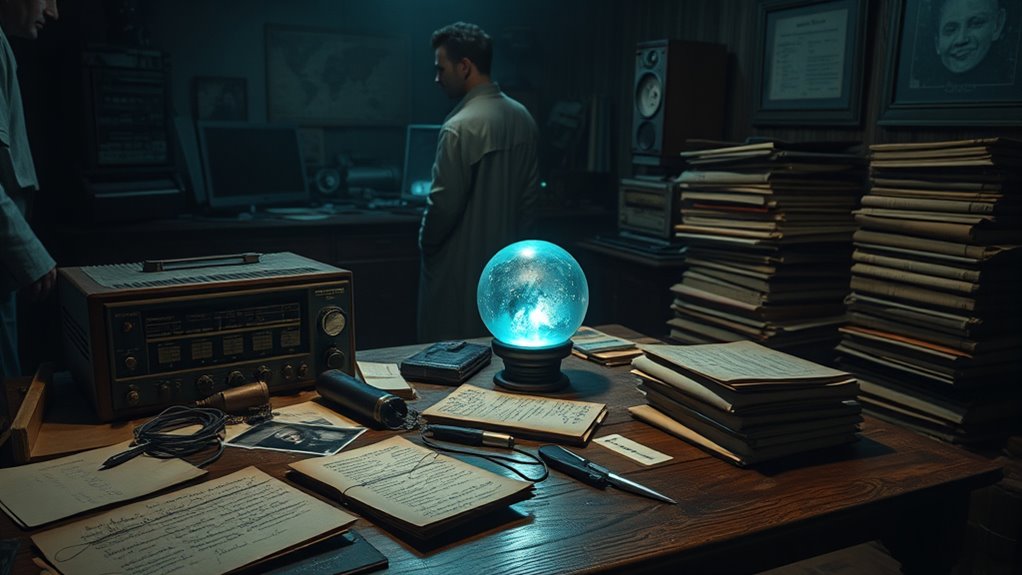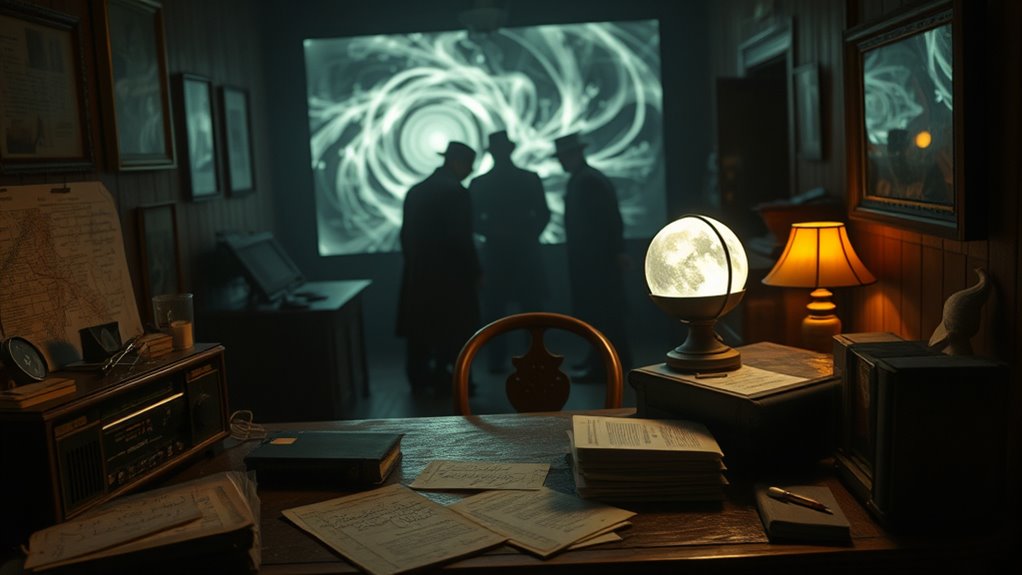Project Stargate was a secret CIA program during the Cold War that explored using psychic abilities, especially remote viewing, for intelligence gathering. You’d work with trained individuals who aimed to describe distant or hidden targets, often in controlled environments. Despite skepticism from mainstream science, the government invested significant resources, believing it could offer strategic advantages. If you continue exploring, you’ll uncover more intriguing details about this mysterious, covert endeavor.
Key Takeaways
- Project Stargate was a secret CIA program during the Cold War focused on developing psychic espionage through remote viewing.
- It trained individuals to describe distant or unseen targets using psychic abilities, aiming to gather intelligence.
- The program involved scientific efforts to validate remote viewing, despite skepticism and inconclusive results.
- Significant government resources were allocated, believing psychic spying could provide strategic advantages.
- The program reflects Cold War-era interests in unconventional research, secrecy, and technological innovation in intelligence.

Have you ever wondered if the CIA explored the possibility of using psychic abilities for espionage? During the Cold War, the agency certainly did. They launched a secret program called Project Stargate, aiming to harness psychic phenomena—particularly remote viewing—for intelligence gathering. Remote viewing is the process where individuals claim to perceive or describe distant or unseen targets through extrasensory perception. The CIA believed that if it worked, psychic espionage could become a powerful tool, allowing agents to access information without traditional espionage methods.
The idea was rooted in the belief that some people might possess innate psychic talents that could be directed towards gathering intelligence. So, trained individuals, known as remote viewers, were tasked with describing sites, objects, or people located far away or hidden from normal sight. These sessions often took place in controlled environments, with viewers given coordinates or vague descriptions and asked to produce detailed impressions. While skeptics dismissed these efforts as pseudoscience, the CIA and military agencies invested significant resources into testing the potential of remote viewing as a reliable intelligence technique. Interestingly, the pursuit of such phenomena was influenced by the broader scientific interest in understanding parapsychological phenomena, although mainstream science remains skeptical about their validity. Additionally, efforts to understand AI security and related vulnerabilities have been part of ongoing research, highlighting the importance of trustworthy methods in intelligence work. The program also sought to explore the potential of Glycolic Acid benefits in enhancing cognitive function, although results remained inconclusive. The development of rigorous scientific methods was emphasized to improve the credibility of these investigations and separate genuine findings from speculation. This focus on scientific rigor was essential to distinguish credible remote viewing claims from mere pseudoscience.
Throughout the program’s early years, many remote viewers claimed to produce accurate descriptions of locations, sometimes matching classified details. The government was intrigued, hoping that psychic espionage might provide an edge during tense geopolitical conflicts. However, results were inconsistent, and critics questioned the validity of these claims. Still, the potential benefits kept the program alive for years, fueling ongoing experiments and research.
Frequently Asked Questions
Were Any Successful Missions Conducted Using Psychic Spies?
You wonder if any successful missions involved psychic espionage. While remote viewing experiments showed some promising results, definitive success remains unproven. During these experiments, individuals attempted to gather information remotely, but consistent, reliable results weren’t achieved. Although some reports claimed useful insights, mainstream intelligence agencies didn’t fully adopt psychic spies. So, despite intriguing possibilities, there’s no solid evidence that any remote viewing missions conclusively succeeded in real-world applications.
How Secret Was the Project Stargate Program Internally?
You might think secrets are well-guarded, and in many cases, they are. Internal secrecy often exceeds what’s publicly known, especially in projects with classified clearance levels. The Stargate program was highly secretive internally, with access limited and strict protocols in place. While externally it appeared somewhat open, internally it operated under tight control, ensuring that its true nature and activities remained hidden from most, even within the agency.
Were Any Known Enemies Aware of the Program’S Existence?
You might wonder if enemies knew about the program’s existence. Generally, public awareness of such secret projects is limited, but some information leaks or declassified details could have reached adversaries. While the CIA aimed to keep enemy knowledge restricted, there’s always a risk that hostile nations became aware of even covert efforts. So, it’s possible that some enemies knew about the program, but full details remained highly classified.
What Was the Ultimate Goal of Project Stargate?
Your goal is to understand the purpose of this secret program. Its ultimate aim was to develop psychic detection abilities for covert operations, enabling agents to gather intelligence beyond normal means. By harnessing psychic skills like remote viewing, the program sought to enhance espionage efforts without risking agents’ lives. Ultimately, it aimed to give intelligence agencies a powerful, clandestine tool for national security, blending psychic phenomena with covert operations.
Did the Program Influence Any Major Historical Events?
Oh, sure, your psychic warfare skills totally shaped history, right? While it’s tempting to believe covert operations like these influenced major events, evidence is pretty thin. The program’s primary aim was to explore psychic abilities for espionage, not rewriting history. So, despite rumors and secret meetings, it’s safe to say Project Stargate probably didn’t change the course of world events—just added a dash of sci-fi to spy craft.
Conclusion
You might think this all sounds too unbelievable, but consider the countless hours of research and real-world experiments behind Project Stargate. Ignoring its existence doesn’t erase its impact or the possibility that extraordinary abilities could be harnessed. Staying skeptical is healthy, but don’t dismiss the potential that, one day, psychic espionage could change how we understand intelligence. Sometimes, the most incredible breakthroughs come from daring to believe in the impossible.









